Mild, dry and sunny
- The average national temperature for March 2025 (using the Island of Ireland dataset*) was 8.55 °C, which is 1.42 °C above the most recent 1991-2020 long-term average (LTA) and 2.09 °C above the 1961-1990 LTA. March 2025 was the 8th warmest on record since 1900 and the warmest since 2012.
- The warmest March remains in 1957 (68 years ago) with an average temperature of 9.85°C and the coldest March remains in 1919 (106 years ago) with an average temperature of 3.90°C.
- Provisional gridded rainfall data suggests March 2025 averaged at 36.2 mm (38% of the 1991-2020 LTA or 35% of the 1981-2010 LTA).
- The wettest March was in 2023 (2 years ago) and the driest March was in 1944 (81 years ago).
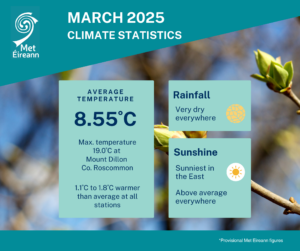
March 2025 Climate Statistics
March 2025 was very mild and dry. It was also sunny, especially in the East. High pressure dominated through most of the month with weak steering currents aloft. The first week was relatively dry but cloudy at times with high pressure over and to the south of Ireland. The high pressure gradually pulled away to the east during the second half of the week, allowing Atlantic weather fronts to push in from the west bringing outbreaks of mostly light rain. The second week saw low pressure stay to the south of Ireland with high pressure building to the northwest. This brought a period of easterly winds, which gradually backed northerly. A mild first half of the week gave way to a cooler second half, as a Polar maritime airmass pushed down from the north. It stayed mostly dry and became sunnier. The third week saw high pressure to the west gradually move over Ireland and then to the east, keeping it dry with plenty of sunshine for most of the week. It became milder again towards the end of the week as the winds became south-easterly and then southerly. The wettest period of the month was Friday 21st and Saturday 22nd when low pressure to the south pushed weather fronts north over the country, with some heavy rain in places, especially in the South and West. The rest of the month saw high pressure building to the south again with low pressure to the north. Some relatively weak weather fronts crossed the country from the west followed by showers at times but overall high pressure to the south dominated bringing a lot of dry and mild conditions with sunny spells.
Rainfall: Very dry everywhere
- Dunsany, Co Meath and Mace Head, Co Galway also had their driest March on record (length 61 and 20 years).
- Ballyhaise, Co Cavan had its driest March since 1953, Gurteen, Co Tipperary had its driest March since 1961 and Dublin Airport had its driest March since 1990.
- There were two dry spells* ending in March 2025.
- The last time all synoptic stations were below the 1991-2020 LTA for rainfall during any month was in July 2024.
- This is only the second time that all synoptic stations were below the 1991-2020 LTA for rainfall in March, the other time being March 2012.
All monthly rainfall totals across the country were below their 1991-2020 Long-Term Average (LTA). Percentage of monthly rainfall values ranged from 18% (11.2 mm) at Dunsany, Co Meath (its driest March on record (length 61 years)) to 64% (32.8 mm) at Casement Aerodrome, Co Dublin. Monthly rainfall totals ranged from 11.2 mm (18% of its LTA) at Dunsany, Co Meath to 59.3 mm (46% of its LTA) at Newport, Co Mayo (its driest March since 2013). The highest daily rainfall total was 25.4 mm at Cork Airport, Co Cork on Friday 21st. The number of rain days* ranged from 7 days at Oak Park, Co Carlow to 18 days at both Markree, Co Sligo and Knock Airport, Co Mayo. The number of wet days* ranged from 4 days at a few stations to 12 days at Belmullet, Co Mayo. The number of very wet days* ranged from zero days at 10 stations to 2 days at a few stations. Along with Dunsany, Co Meath, Mace Head, Co Galway also had its driest March on record with 26.4 mm (length 20 years). Ballyhaise, Co Cavan with 20.4 mm had its driest March since 1953. Gurteen, Co Tipperary with 28.2 mm had its driest March since 1961 and Dublin Airport with 13.5 mm had its driest March since 1990. Two stations had dry spells*. These were Ballyhaise, Co Cavan between 27th February and 20th March lasting 22 days and Finner, Co Donegal between 6th March and 20th March lasting 15 days.
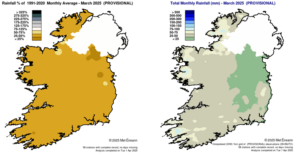
Rainfall % of 1991 – 2020 Monthly Average for March 2025 (Provisional) Total Monthly Rainfall (mm) for March 2025 (Provisional)
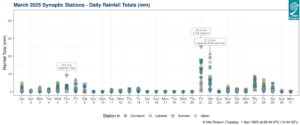
March 2025 Synoptic Stations – Daily rainfall totals (mm)
Temperature: Significantly above average everywhere
- 19.0 °C is the highest maximum for March at Mount Dillon, Co Roscommon since 2012 and the highest March maximum at any stations since 2017.
- Thirteen stations had their warmest March since 2012 and twelve stations had their warmest March since 2017.
All mean air temperatures across the country were above their LTA for the month. Deviations from mean air temperature ranged from +1.1 °C (9.2 °C mean temperature) at Sherkin Island, Co Cork to +1.8 °C (7.5 °C mean temperature) at Knock Airport, Co Mayo (its warmest March since 2012). Mean temperatures for the month ranged from 7.5°C at Knock Airport, Co Mayo (1.8°C above its LTA), Dunsany, Co Meath (1.2°C above its LTA) and Mullingar, Co Westmeath (1.3°C above its LTA) to 9.6 °C (1.5 °C above its LTA) at Valentia Observatory, Co Kerry (its warmest March since 2012). All the month’s highest and lowest temperatures were recorded at Mount Dillon, Co Roscommon with both lowest air and grass minimum reported on Saturday 15th. The lowest air minimum temperature was -4.6 °C while the lowest grass minimum was -10.5 °C. The highest maximum was reported on Monday 31st with a temperature of 19.0 °C (its highest maximum for March since 2012 and the highest March maximum at any stations since 2017). All stations reported ground frost during the month. The number of days with ground frost ranged from 3 days at Sherkin Island, Co Cork to 19 days at Phoenix Park, Co Dublin. More than half of stations reported air frost. The number of days with air frost ranged from zero days at a few stations to 7 days at Dunsany, Co Meath. Thirteen stations had their warmest March since 2012 and twelve stations had their warmest March since 2017.
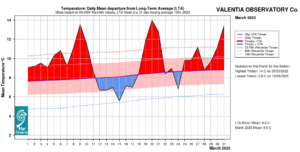
Valencia Observatory, Co Kerry Temperature: Daily mean departure from LTA for March 2025 based on 09-09hr Max/Min values.
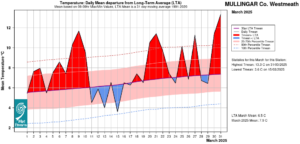
Mullingar, Co Westmeath Temperature: Daily mean departure from LTA for March 2025 based on 09-09hr Max/Min values.
Sunshine: Above average everywhere, sunniest in the East
All available sunshine totals were above their LTA. Percentage of monthly sunshine values ranged from 115% (128.4 hours) at Shannon Airport, Co Clare to 132% (141.3 hours) at Casement Aerodrome, Co Dublin. Monthly sunshine totals ranged from 115.8 hours (No LTA comparison*) at Cork Airport, Co Cork to 154.4 hours (No LTA comparison*) at Dublin Airport, Co Dublin. The highest number of daily sunshine hours recorded this month was 11.3 hours at Belmullet, Co Mayo on Wednesday 19th. The number of dull days* ranged from 4 days at Dublin Airport to 9 days at a few stations.

Hours of Bright Sunshine observed at nine stations for each day of the month of March 2025, grouped by province relative to the highest number of hours possible by end of month (shaded box).
Wind: Not significantly strong with gales reported at one station
Monthly mean wind speeds ranged from 5.7 knots (10.6 km/h) at Ballyhaise, Co Cavan to 13.7 knots (25.4 km/h) at Malin Head, Co Donegal. Gales were reported on Friday 28th at Mace Head, Co Galway. The number of days with gales ranged from zero days at most stations to 1 day at Mace Head, Co Galway. There were no strong gales or storm force winds reported. The month’s highest 10-minute mean wind speed was reported at Mace Head, Co Galway on Friday 28th with 34 knots (63 km/h), while the month’s highest gust was reported on Saturday 29th at Malin Head, Co Donegal with 46 knots (85 km/h).
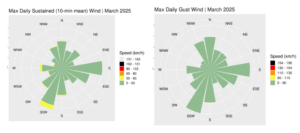
Wind roses for March 2025, sustained 10-min mean and gust.
The full report is available here.

Extreme values for March 2025 at synoptic stations.
*Issued by Met Éireann on Wednesday 2th April 2025. This report is based on available preliminary data from 25 principal weather stations operated by Met Éireann. Synoptic station data is midnight to midnight UTC. Long-Term Averages (LTAs) and “average” refer to the period 1991-2020 unless stated. A rain day is a day on which 0.2 mm or more of rainfall is measured. A wet day is a day with 1.0 mm or more of rainfall. A dull day is a day with less than 0.5 hours of sunshine. A very wet day is a day with 10.0 mm or more of rainfall. Climatological dry periods – An absolute drought is a period of 15 or more consecutive days to none of which is credited 0.2 mm or more of precipitation. A partial drought is a period of at least 29 consecutive days, the mean daily rainfall of which does not exceed 0.2 mm. A dry spell is a period of 15 or more consecutive days to none of which is credited 1.0 mm or more of precipitation (i.e. daily tot < 1.0 mm). A heatwave occurs where there are 5 consecutive days or more with maximum temperature over 25°C (that is, a daily maximum screen air temperature > 25° C). The ‘Island of Ireland’ dataset is 125 years long and runs between 1900 and 2023. For this dataset the long term averages from the 1961-1990 reference period are used for comparison as is standard for long-term climate change assessments. *Sunshine data is from the Autosol Network. LTAs for these sites are currently not used for comparison purposes. For more information, contact Met Éireann at 01-8064200 or e-mail: enq@met.ie